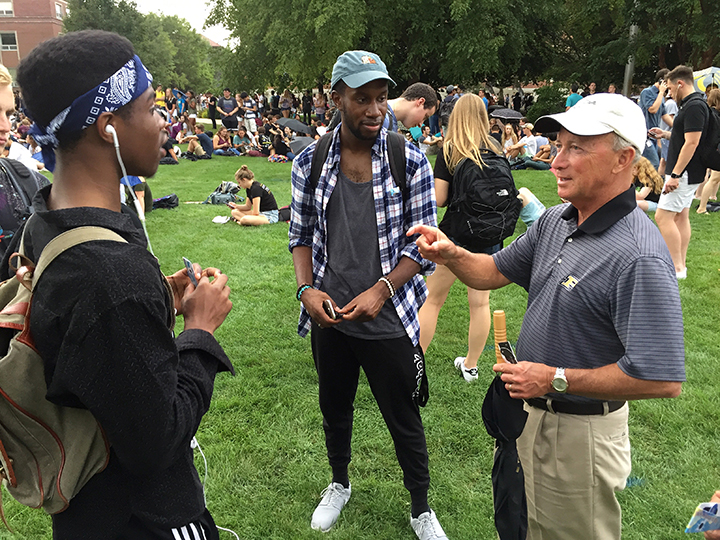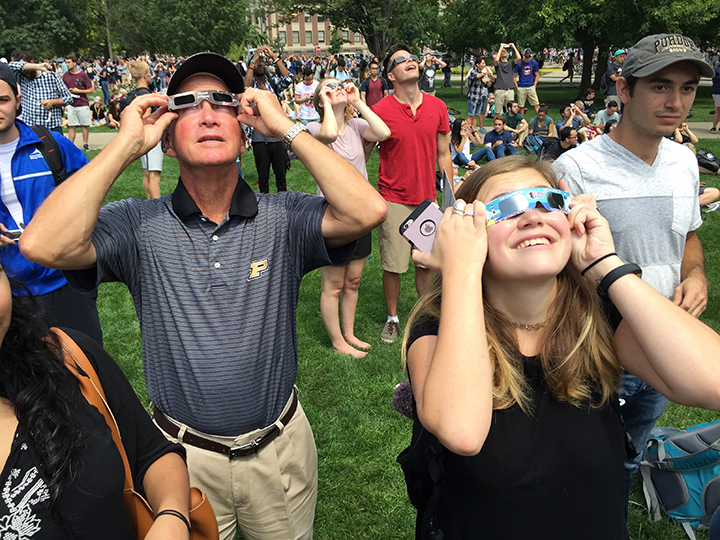September 1, 2017
Dear Alumni and Friends,
It’s been another year of accomplishments by the people of your university. So many important achievements occurred in the realm of research that this month’s update will be almost solely devoted to that area.
In a year of general and widespread uncertainty for research funding, our Purdue researchers and those who support them once again saw record research awards, which, along with increased investment in research infrastructure, helps ensure that these outstanding scientists are able to continue their world-changing work. There has been nothing like it in Purdue history.
Despite the current budgetary uncertainty in Washington, D.C., our research awards for the just-concluded fiscal year have again reached a record level, with sponsored funding reaching $418.3 million, nearly $15 million higher than last year’s previous record.
Strategic Partnerships
Some three years ago, we created an Office of Corporate and Global Partnerships and placed in it the Office of the Executive Vice President for Research and Partnerships. The idea was to make it much easier for potential outside research sponsors to locate suitable researchers and make contracting easier when a good match is identified. Many of our recent breakthroughs came through such partnerships, including:
Microsoft
In May, we announced a multimillion dollar, multi-year partnership with Microsoft to develop a usable and scalable quantum computer, a never-before-created technology that would allow researchers across a variety of disciplines to solve problems that are impossible for today’s computers.
Purdue is one of just four international universities in this collaboration with Microsoft, each bringing its own expertise. Purdue’s role, led by Michael Manfra, professor of physics and astronomy, materials engineering, and electrical and computer engineering, will be to grow and study ultra-pure semiconductors and hybrid systems of semiconductors and superconductors that may form the physical platform on which a quantum computer is built.
The work at Purdue, which will include Microsoft employees working side-by-side with Purdue researchers, will be done in the Birck Nanotechnology Center in the university's Discovery Park, where the tools and laboratories available to our researchers have enabled Purdue to become a world leader in this type of research, as well as in the Department of Physics and Astronomy.
Eli Lilly
Last month, we announced a strategic collaboration with Eli Lilly and Co. to conduct important life science research in improving the delivery of injectable medicines and in the creation of predictive models to forecast the success and reduce the risks of drug discovery. This agreement is an early dividend from our five-year, $250 million investment in the life sciences announced last year.
This new five-year agreement with Lilly, in which Lilly has committed up to $52 million, marks Purdue’s largest-ever collaboration with a single company, building on our long history of engagement with the Indiana company and supporting a core aspect of both our missions. Purdue researchers in natural and physical sciences, engineering and veterinary medicine all will collaborate with Lilly researchers on this important research.
Rolls-Royce
During the International Paris Air Show in June, we entered a $24 million jointly funded program with Rolls-Royce, supported in part by the Indiana Economic Development Corporation, to strengthen Indiana’s leadership position in the aerospace industry.
Rolls-Royce had previously committed to conducting at least $33 million in research with Purdue over the six years of 2015 through 2020. This new initiative adds to the previous commitment and will establish unique gas turbine research capabilities, including a new turbine test rig, at Purdue’s Zucrow Laboratories and will allow Rolls-Royce to apply these technologies to jet engine components produced at its Indiana facilities.
Zucrow Laboratories, which is located in the Purdue Research Park Aerospace District, is one of the nation's oldest and most significant university propulsion laboratories for research to reduce fuel consumption and emissions for next-generation jet engines. It was expanded and modernized over the last year and a half as part of our overall engineering investment through the Purdue Moves initiatives.
WestGate Authority and NSWC Crane
Also in June, Purdue signed a collaborative agreement with WestGate Authority and the Naval Surface Warfare Center Crane Division (NSWC Crane) to further advance educational, research and development, and technology commercialization across Indiana and the region surrounding the southern part of our state.
The soon-to-be-established WestGate Academy Conference and Training Center in Odon, Indiana, will house facilities to advance new technologies and startup creation among WestGate, NSWC Crane and Purdue, each bringing its own vast strengths to the table, establishing a valuable asset neighboring the world-renowned Crane facility, from which many Indiana residents will benefit educationally and economically.
The Purdue Krannert School of Management and the Polytechnic Institute will provide educational opportunities at the center, while the Purdue Office of Technology Commercialization and the Purdue Foundry will provide support for tech transfer and startup creation. The Purdue Research Park also will support the center with company incubation space.
Infosys
Just two weeks ago, we signed a five-year agreement with Infosys, a top global provider of business consulting and IT services, to support the development of the U.S. technology workforce, along with millions of dollars of joint research innovation in the areas of cybersecurity, artificial intelligence and data analytics, among several others. As part of the agreement Purdue will provide courses and specialized training for many of the 10,000 American employees, including 2,000 in Indiana, that Infosys will hire over the next two years.
This partnership supports directly our efforts to increase educational and real-world, hands-on opportunities for our students, particularly those within the rapidly evolving tech industry.
And if all of these great successes aren’t enough, stand by for another important research announcement in the coming weeks.
Research Awards
Individually, our researchers are also making significant discoveries and being recognized widely for their important contributions.
Here are highlights from our researchers’ great year, across a variety of disciplines:
- Catherine Hill; entomology — developed a way to respond to new and re-emerging vector-borne diseases, especially the viruses that cause West Nile, dengue, Zika and yellow fever, without wiping out the mosquito population.
- Srinivasan Chandrasekar; industrial engineering — revealed mystery behind shatter-resistant behavior behind Prince Rupert’s drops.
- John Cushman; earth, atmospheric and planetary sciences and mathematics — developed an “instantly rechargeable” battery for electric and hybrid cars that is safe, affordable and environmentally friendly that charges through a process similar to refueling a car at a gas station.
- Lawrence Mykytiuk; library science — verified the historic existence of 53 people mentioned in Hebrew Bible.
- Jonathan Wilker; chemistry and materials engineering — developed a new type of polymer adhesive, based on an adhesive protein in mussels that keeps them stuck to their shells, that can be used underwater and performs better than a dozen current commercial adhesives.
- Wayne Campbell and Jung Eun Kim; nutrition science — found that adding eggs to salad boosts the amount of vitamin E the body absorbs from the vegetables.
- Amanda Veile; biological anthropology — established strong evidence tying cesarean birth to future obesity in the child, implying that birth methods could play a role in how children develop
- Bill Muir; animal science and genetics — identified 930 genes associated with alcoholism, indicating that finding effective pharmaceutical treatment for the disease in humans could be difficult
- Catherine Aime; botany and plant pathology — discovered a third previously unknown symbiotic partner in lichen, overturning several longstanding scientific assumptions about the symbiosis.
In May, we announced that three of Purdue’s top researchers will be celebrated this fall with the university’s most prestigious awards in the areas of pure and applied science and engineering, the humanities and social sciences, and natural science.
Mikhail Atallah, Distinguished Professor of Computer Science and professor of electrical and computer engineering, received the 2017 Arden L. Bement Jr. Award for his significant contributions in the design and implementation of solutions to some of the most challenging computer processing and security issues, which have influenced greatly many areas in the cybersecurity field.
Michele R. Buzon, professor of anthropology, was recognized with the 2017 Research and Scholarship Distinction Award for her groundbreaking work in bioarchaeology in the Nile River Valley region, which has gained wide recognition throughout the U.S. and around the world.
Jean A. Chmielewski, the Alice Watson Kramer Distinguished Professor of Chemistry and professor of biomedical engineering, received the 2017 Herbert Newby McCoy Award for her pioneering impact on the fields of chemical biology and drug discovery, in which her work, which has enabled antibiotics to penetrate infected cells more efficiently, will facilitate better treatment of certain infections.
We also recently celebrated Purdue’s innovations in mass spectrometry with some of the most prominent members of the mass spectrometry community, including Purdue’s own R. Graham Cooks, the Henry Bohn Hass Distinguished Professor of Chemistry, widely recognized as a pioneer of tandem mass spectrometry, molecular secondary portable mass spectrometry and miniature portable mass spectrometers, allowing mass spectrometry to be employed more easily in sometimes messy field environments rather than in a sterile lab.
Professor Cooks’ most recent developments include instruments capable of distinguishing cancerous from healthy tissue during brain surgery, and devices that can identify a drug in a drop blood in tens of seconds, replacing methods that often require hours. These new developments help optimize therapies for individual patients and are a critical component in initiatives such as the National Cancer Moonshot.
NewU Update
In other news, we’ve recently made more progress in acquiring Kaplan University and transitioning that institution into what we are temporarily calling Purdue NewU.
In particular, the NewU board during its inaugural meeting announced an approximately 45 percent tuition discount for Indiana resident students pursuing an associate or bachelor’s degree, a 10 percent discount for Hoosier students pursuing a master’s degree or graduate certificate and a significant discount for Purdue employees (free tuition for benefits-eligible staff) and their families. This is an important step in accomplishing our goal of extending Purdue’s land-grant mission to serve the 1.5 million Hoosiers over the age of 25 with little or no college education through this acquisition.
Over the last several weeks, we’ve also hosted listening sessions for Purdue faculty and staff and visited a Kaplan campus in Iowa and its administrative offices in Chicago.
On August 10, the Indiana Commission for Higher Education unanimously approved Purdue’s proposal to acquire Kaplan University. We look forward to receiving the remaining necessary approvals from the U.S. Department of Education and the Higher Learning Commission later this year.
As always, your ideas, concerns and questions are critical as we move forward on this important initiative. Please send any questions and ideas to newuniversity@purdue.edu.
Purdue Polytechnic Indianapolis High School
The long-anticipated Purdue Polytechnic High School Indianapolis officially welcomed its first cohort of students, 159 ninth-graders, on July 31. Nearly a month in, the school’s leadership reports that the year is off to a great start.
Eclipse Festivities
Last Monday, I took in the Great American Eclipse alongside several hundred fellow Boilermakers on the Purdue Memorial Mall. What a fittingly momentous way to mark the start of a new academic year.


There’s much more to report, but with a new school year underway, record enrollment on the books, and the first game of a new chapter in Boilermaker football just hours away, we’ll be writing again very soon.
Boiler Up!
Mitch Daniels
President